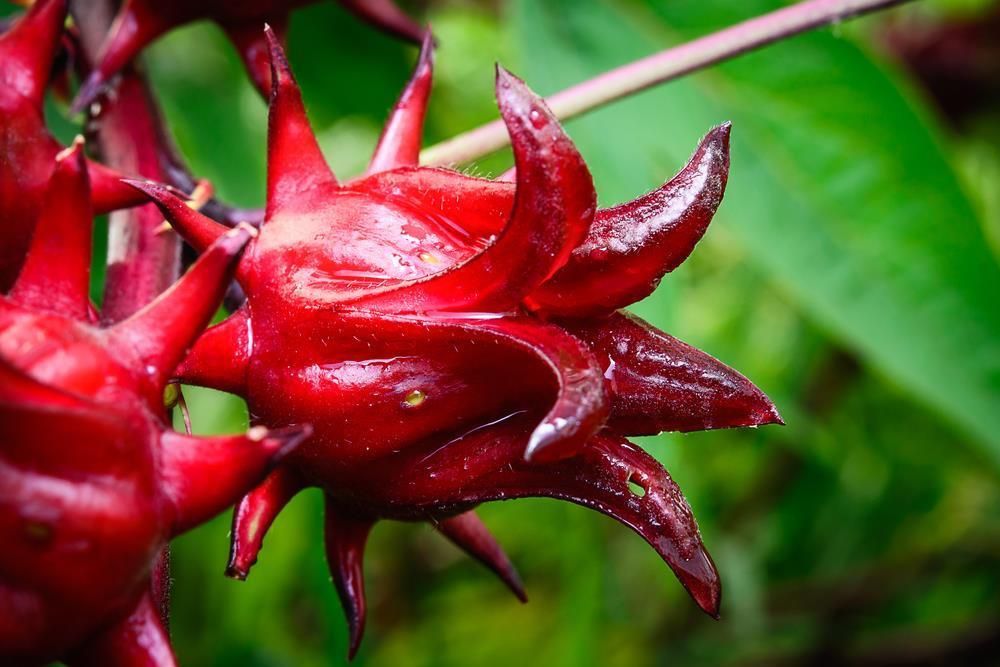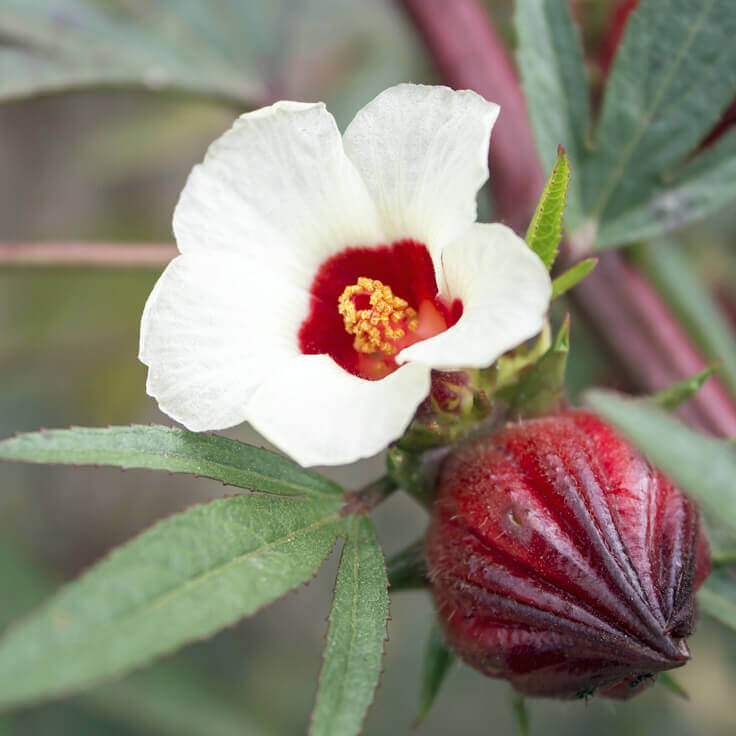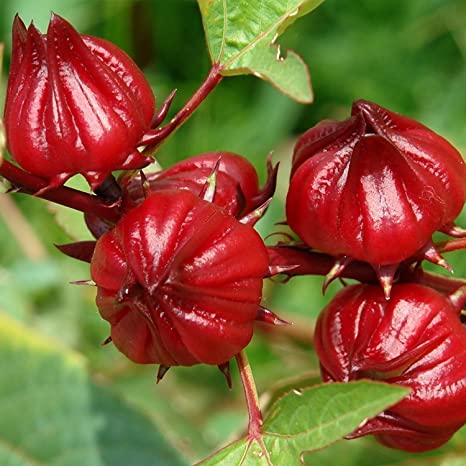Roselle plant
TRADITIONAL MEDICINAL USES
Africa. Hot water extract of seeds is taken as a diuretic and tonic. Seed oil is used externally to heal sores on camels sols.
Brazil. Hot water extract of root is taken orally as a stomachic and externally as an emollient So18.
Cameroon. Hot water extract of dried leaves is taken orally as an anthelmintic So49.
Congo. Hot water extract of leaves is taken orally to expedite delivery soo9.
East Africa. Hot water extract of leaves is taken orally to relieve coughs sol8. Unripe fruit juice is taken orally with salt, pepper, asafetida and molasses as a remedy for biliousness.Hot water extract of leaves is used as a flavoring agent, diuretic, choleretic, febrifuge and hypotensive, to decrease viscosity of blood and to stimulate intestinal peristalsis. Externally, the extract is used for sores and wounds sol8.
Egypt. Decoction of hot water extract of the calyx is taken with sugar 3 times daily for high blood pressureHS016.Hot water extract of the entire plant is taken orally for heart and nerve diseases, as a laxative, to reduce weight, as a diuretic, to activate and neutralize hepatic secretion, to activate gastric secretion, as a digestive, for arteriosclerosis, as a diaphoretic, to give a euphoric impression and as an intestinal antiseptic soo8. Leaf essential oil is taken orally to treat cancer HS015.
Guatemala. Hot water extract of dried calyx is taken orally as a diuretic and for renal inflammation so5o.
Guinea-Bissau. Seeds are taken orally by males as an aphrodisiac sol8.
India. Hot water extract of leaves is taken orally as a diuretic, choleretic, febrifuge and hypotensive, to decrease blood viscosity and to stimulate intestinal peristalsis sol8.Water extract of seed is taken orally to relieve dysuria and strangury, for mild cases of dyspepsia and to relieve debility Sol8.
Mexico. Hot water extract of leaves is taken orally as a diuretic, choleretic and febrifuge, for hypotension, to decrease viscosity of the blood and to stimulate intestinal peristalsis so18.
Senegal. Hot water extract of leaves is used externally on wounds soll, and orally to lower blood pressureHS018.Hot water extract of flowers is taken orally to combat fatigue, for indigestion and as a diaphoretic, cholagogue and diuretic SOIJ.
Sierra Leone. Decoction of dried leaves is taken orally to treat postpartum hemorrhage, to initiate contractions and as a diuretic during pregnancy (mixed with leaves of Dialium guineense )HS044.
Sudan. Hot water extract of flowers is taken orally as a blood purifier solo. Hot water extract of the dried flowers is taken orally for coughs Hso41.
Thailand. Decoction of dried calyx is taken orally for high blood pressure S054.Roselle belongs to Malvaceae family. It is an erect, mostly branched, annual shrub. Stems are reddish in color and up to 3.5 m tall.Leaves are dark green to red, alternate, glabrous, long-petiolate, palmately divided into 3–7 lobes, with serrate margins.
Medicinal Uses
Roselle plant takes about six months to mature. In some places, the plant is primarily cultivated for the production of bast fibre from the stem of the plant. The fibre may be used as a substitute for jute in making burlap. The red calyces of the plant are used as food colourings and dyes. Today, roselle is attracting the attention of food and beverage manufacturers and pharmaceutical concerns who feel it may have exploitable possibilities as a natural food product for herbal medicine and as a colorant to replace some synthetic dyes.Roselle is used in many folk medicines. It is valued for its mild laxative effect and for its ability to increase urination, attributed to two diuretic ingredients, ascorbic acid and glycolic acid. Because it contains citric acid, it is used as a cooling herb, providing relief during hot weather by increasing the flow of blood to the skin’s surface and dilating the pores to cool the skin. The leaves and flowers are used as a tonic tea for digestive and kidney functions. The heated leaves are applied to cracks in the feet and on boils and ulcers to speed maturation. The calyces and seeds are diuretic, laxative and tonic. The ripe calyces, boiled in water, can be used as a drink to treat bilious attacks. A lotion made from rosella leaves is used on sores and wounds.


Food Uses and Value
The nutritional analysis of roselle plant by proximate method (Luvonga et al. 2010) found the carbohydrate content (68.7%) was highest followed by crude fibre (14.6%) and ash content (12.2%) and others.The plant is also found to be rich in minerals especially potassium and magnesium.Vitamins (ascorbic acid, niacin and pyridoxine) were also present in appreciable amounts.Many parts of rosella including seeds, leaves, fruits and roots are used in various foods.Among them, the fleshy red calyces are the most popular. They are used fresh for making wine, juice, jam, jelly, syrup. gelatin, pudding, cakes, ice cream and flavors and also dried and brewed into tea, spice, and used for butter, pies, sauces, tarts, and other desserts.The calyces possess pectin that makes a firm jelly.The young leaves and tender stems of rosella are eaten raw in salads or cooked as greens alone or in combination with other vegetables and/or with meat.They are also added to curries as seasoning.They have an acid, rhubarb-like flavor.The fresh calyces are also rich in riboflavin, ascorbic acid, niacin, carotene, calcium, and iron that are nutritionally important.The seeds, are high in protein, can be roasted and ground into a powder then used in soups and sauces.The roasted seeds can be used as a coffee substitute.The young root is edible, but very fibrous.
Antimicrobial properties
Roselle is widely used for the treatment of diseases. Olaleye (2007) used the aqueous ethanolic extract of roselle to investigate its phytochemical constituents, antimicrobial activity and cytotoxicity, and reported that the extract contained cardiac glycosides, flavonoids, saponins and alkaloids.It exhibited antibacterial activities against Staphylococcus aureus, Bacillus stearothermophilus, Micrococcus luteus, Serratia marcescens, Clostridium sporogenes, Escherichia coli, Klebsiella, pneumoniae, Bacillus cereus, Pseudomonas fluorescence.The results support the use of this plant in the treatment of diseases like abscesses, bilious conditions, cancer and coughs in traditional medicine, and also suggest the possibility of isolating antibacterial and anticancer agents while the antimicrobial activity on Escherichia coli O157:H7, Salmonella enterica and Listeria monocytogenes isolates from food, veterinary, and clinical samples by Fullerton (2011) indicated that roselle extract was effective and suggest the application of extracts as potential antimicrobials in foods.
Antioxidant properties
Roselle – Hibiscus anthocyanins (HAs) which are a group of natural pigments existing in the dried calyx exhibited antioxidant activity and liver protection.The histopathological evaluation of the liver revealed that roselle pigments reduced the incidence of liver lesions including inflammatory leukocyte infiltration, and necrosis induced by tert-butyl hydroperoxide (t-BHP) in rats An antioxidative activity was also reported in cancerous cell lines . In animal models , extracts of its calyces have demonstrated hypocholesterolemic and antihypertensive properties irrespective of age, gender or dietary supplement used.


